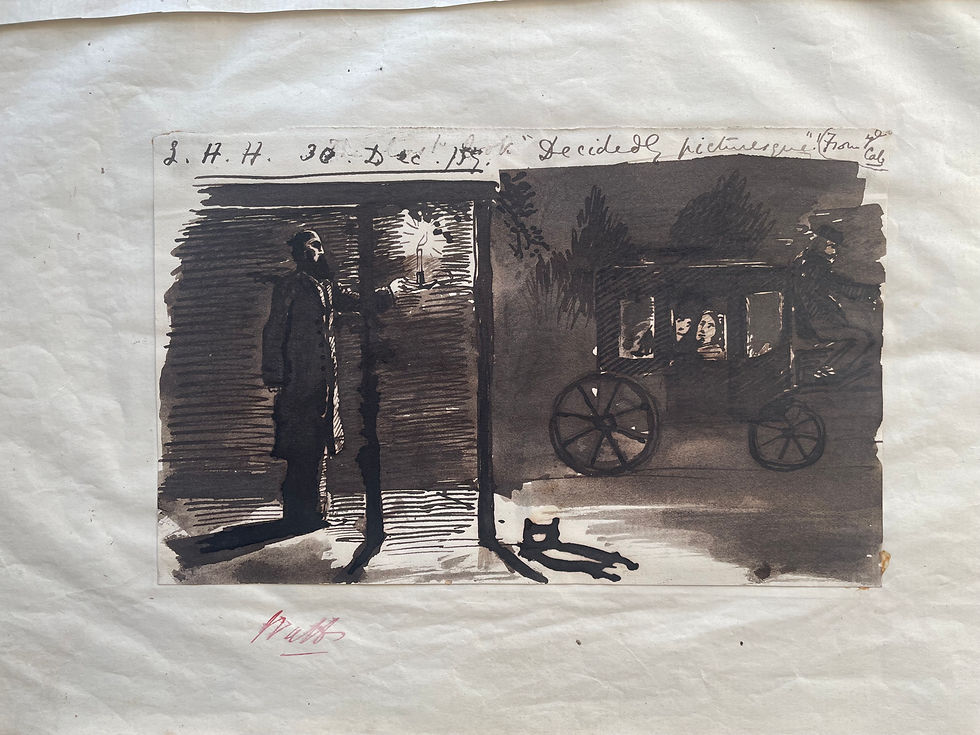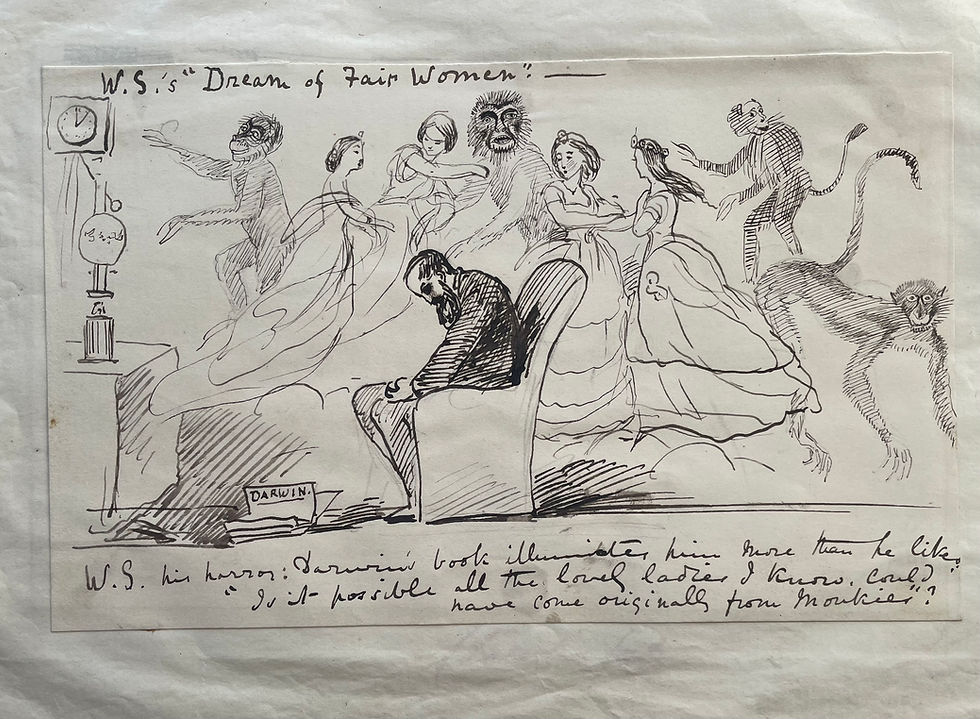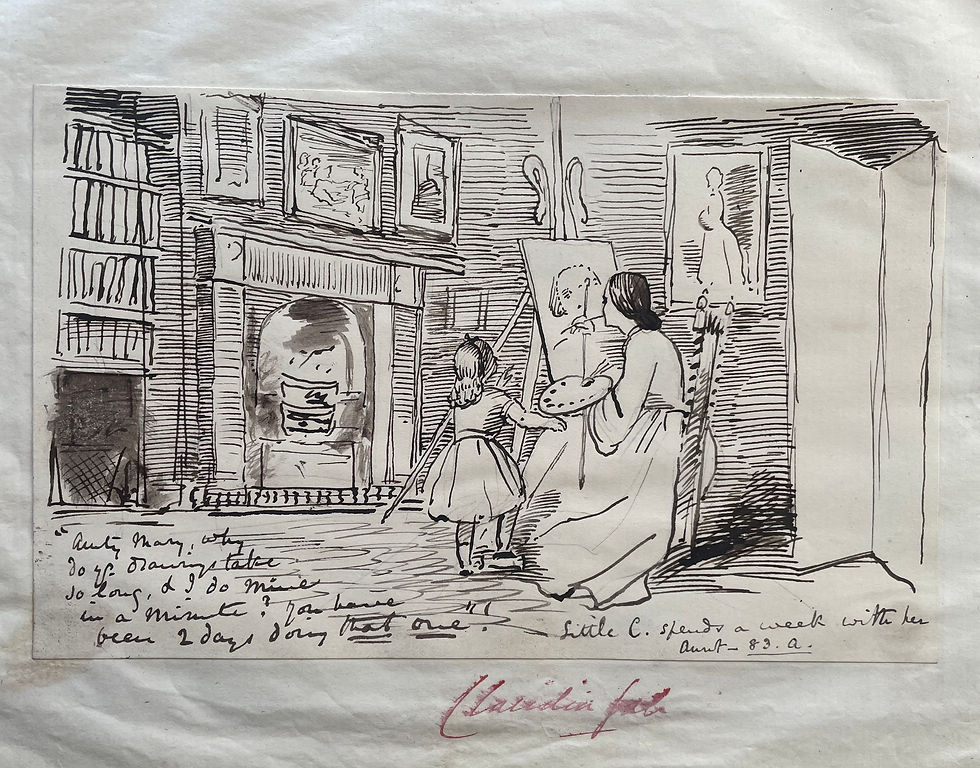Private Sketches by M.S.: Moments from 1859 & 1860
- Debbie Challis
- Oct 5
- 4 min read

Yesterday I blogged about how much I enjoyed rummaging in archives. The love notes between Joseph Severn and his future wife Elizabeth were one example, but what made me laugh out loud was the 'Private Sketches' by Mary Severn from December 1859 / January 1860. Mary's ability to laugh at herself, her family and great artists - like G. F. Watts - and record it, is part of her immense talent. I have uploaded the whole sketch book here. At this time, Mary's mother Elizabeth and younger sister Eleanor were away in Hanover for Eleanor to learn German. Mary was working in 83a Ecclestone Square - their home since early 1858 - with her older brother Walter, younger brother Arthur and father Joseph.
Admittedly, I am a sad nerd who - in my head - lives as much in the 1850s and 1860s as the current day so got many of the references and allusions that Mary satiritically makes. So, at risk, of displaying my full nerdery, I want to share some sketches and explain why I found them funny.
G. F. Watts stands outside Little Holland House with a candle seeing Mary and Arthur off. Little Holland House was leased by the Prinsep family (more here) and where the painter George Frederich Watts lived for over 20 years.

Mary finds the scene of Watts with a candle 'decidely picturesque', a joke given Watts' serious reputation and his own eye for the picturesque and beauty.

Influenced by Watts, Mary shows herself starting on a massive face in order to make the kind of colossal work Watts was known for - colossal in scale and theme. The books on her shelf point to her classical and Romantic interersts and aspirations: Herschel (Astronomy), Grote (History of Greece), Greek poets and tragedians Homer, Aristotle, Aeschylus, Greece, Muller (probably The Dorians - Greece), Schelgel (philosophy)*, Shakespeare, Tennyson and, of course, Keats.
*Schelgel's wife was aunt to the composers Felix and Fanny Mendelsohn, whom the Severns knew.

Walter Severn, Mary's older brother, reads Darwin's On the Origin of the Species soon after it is published on 24 November 1859. In letters and other sketches, Mary pokes fun at her older brother's eye for ladies, joking that he moans about going to a party to walk her back home at midnight but is mesmerised by pretty faces to stay until 2am.

Little C. is Mary's older sister's daughter, Claudia Gale - named after her mother, who had married the lawyer, asports writer and cricketer Frederick Gale in 1852. They had seven children in quick succession and Claudia was frequently ill and exhausted from childbirth. The older children often came to stay with 'Aunty Mary'. This shows Mary working doing childcare.

Mary shows herself to have her head in a book with potentially disastrous consequences for her niece.

As written underneath, the reader of the poetry is Hamilton Aide - a once very well known writer who hosted literary salons and was good friends with Mrs Gaskell, among many others. (More on that here). Mary liked romantic and - to modern eyes - often overblown poetry, which her brother Walter deplored - preferring Darwin and more scientific work. Aide may be reading from Confidences, his poetic follow up to his novel Rita; both of which had a risque reputation.

Mary, her brother Walter help a man, who could be Charles Newton, with his research. (I have been in this situation myself many times but rarely had help.)

Joseph Severn protects his daughter Mary (and her work) from the elements. Although Mary is laughing at herself and habits, it is clear here that Mary is the professional artist. It is her study, while her father is reduced to helping her keep the window open and work.

Mary pokes fun at herself not understanding her brother, again, while Arthur watches. The contrast between Walter and Mary is made clear by their books: Walter is reading Darwin and Mary is reading Homer.

